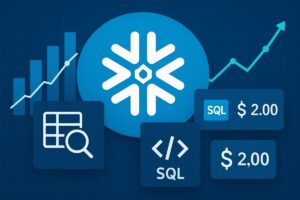Your Snowflake bill just doubled month-over-month. Again. And you have no idea why. Sound familiar?
Compute costs are the usual culprit for skyrocketing Snowflake bills, but most organizations don’t have the time or the tools to keep track of spend. Snowflake’s pay-per-second consumption-based pricing adds a layer of unpredictability that’s hard to account for.
The good news? Your Snowflake spend doesn’t have to be a nasty surprise. You need the right strategies and tools to make costs predictable.
This guide shows you how to regain control. These four actionable strategies will take the question out of your Snowflake bill, helping you optimize spend without having to sacrifice quality.
We’ll cover:
- Snowflake’s primary cost drivers
- Why traditional cost management isn’t an option
- Four actionable Snowflake cost management strategies
What Are Snowflake’s Primary Cost Drivers
To optimize costs, you need to know what’s driving them. Snowflake’s pricing models are a bit different from Databricks or your traditional data warehouse.
Serverless Features
These are any features that operate outside of traditional warehouse controls, like Snowpipe, automatic clustering, and search optimization. These features are designed to be helpful, automatically scaling your workload demands, but the constant shifting makes it hard for you to get an accurate read on costs.
Storage
Snowflake storage costs are based on how much compressed, average monthly data you’re handling. Snowflake does get you a compression rate of 5-10x, but that only gets you so far. Organizations with larger datasets or extensive historical data retention will still struggle with hefty storage costs.
Compute (Virtual Warehouses)
This is the vast majority of your bill. Virtual warehouses consume credits so long as they run, and the larger the warehouse, the more you’ll have to pay. And we’re talking a difference of one credit per hour for a X-Small warehouse to 128 credits per hour for a 6X-Large. That pay-per-second feature means that even a minute wasted is money lost.
Cloud Services Layer
This is your metadata management, access control, and query optimization. You’ll notice a trend here. This is another feature meant to save you money, but depending on your usage patterns, you’ll find that heavy administrative workloads can start to drive up costs.
Why Traditional Cost Management Fails
Snowflake’s consumption-based models are not kind to the typical IT budget. There are no fixed licensing costs. You’ll be faced with fluctuations every pay period because you’re paying for usage. That, combined with a lack of visibility across teams, often leaves you paying far more than you should, and missing patterns that could help you save.
Four Best Snowflake Cost Management Tactics
These are the four best ways to rein in your costs while maintaining your usual workloads.
Cost Management Tactic #1: Optimize Warehouse Configuration
Proper warehouse configuration is the foundation of Snowflake cost management. Don’t waste your time and money running small, fast queries on oversized warehouses with inefficient auto-suspend settings.
Here’s what you’ll need to do here:
- Strategic warehouse separation lets you optimize resource use without sacrificing functionality. Separate your warehouses by function (one for data loading, one for transformation, etc.), to make it easier to sort by performance requirements.
- Use smart auto-suspend settings to reduce idle times. Test a one minute or less suspend instead of sticking with Snowflake’s five minute default.
- Right-size your warehouse by analyzing query patterns to match your warehouse size to the actual requirements of your workload. Don’t use a Larger or X-Large warehouse on a project that would run just fine with a Small.
Pro tip: Sometimes accepting slightly longer query times on smaller warehouses will get you big cost savings.
Cost Management Tactic #2: Implement Smart Cost Controls
Use smart controls as your guardrails to keep expensive mistakes from impacting your bill. Set up the following to improve cost management:
- Access control is your first line of defense. Only allow users who need the compute power access to larger warehouses to prevent junior analysis from running up costs and resources.
- Query timeouts to prevent runaway queries from accumulating massive costs. Don’t rely on Snowflake’s two day default timeout – set actually reasonable limits for your workloads, like 30 minutes for ad-hoc analytics, two hours for standard ETL processes, and longer timeout for long-running batch jobs.
- Assign spending budgets by team, department, project, or user group to create cost accountability and organization-wide transparency.
- Resource monitors send you alerts when spending reaches 75% and 90% of monthly budgets for account and warehouse spending guardrails.
- Auto-shutoff can be useful, but should be used cautiously as automatically suspending warehouses can disrupt critical business functions and provide poor UX.
Cost Management Tactic #3: Gain Complete Cost Visibility
You can’t manage what you can’t see. If you want to control Snowflake costs, you’ll need a way to get full visibility into your spend and the driving factors.
Ask yourself these essential questions:
- What’s driving my monthly spend?
- Which warehouses consume the most credits?
- How much does each query workload actually cost?
- Which teams or users are driving the highest consumption patterns?
You can start with Snowflake’s native cost management tool, Snowsight, but unfortunately that will only get you so far. Snowsight doesn’t give you insight into query-level cost attribution, workload-level cost breakdowns, or any sort of meaningful forecasting analysis.
True cost visibility means taking matters into your own hands or investing in third-party platforms. You’ll have to:
- Implement query-level cost tracking workflows
- Use query tags to identify the team, project, and/or use case each query belongs to
- Create cost dashboards made for different stakeholder groups
The goal here is to turn Snowflake’s opaque credit system into something clear, actionable, and optimizable.
Cost Management Tactic #4: Automated Optimization
Cost management isn’t a one-time task. It requires on-going attention as workloads evolve, data volumes grow, and queries evolve.
Few have the time and resources to give Snowflake cost management the attention it needs to keep Snowflake performance high and costs reasonable. That’s why automated cost optimization is so appealing.
Automated optimizations let you:
- Use dynamic tables for incremental data loads to reduce compute costs
- Implement container services for custom workloads that don’t fit traditional SQL patterns
- Establish automated data retention policies to prevent the accumulation of unneeded storage costs
If you’re not ready to look into a third-party tool to lighten the optimization load, set up automated optimizations to take some of the work off your hands. Otherwise you’re looking at a weekly review to keep up with your optimization needs.
How to Measure Cost Management Success
These are your Snowflake cost management KPIs. Keep a pulsepoint on these metrics so you can better measure the impact of your work.
- Warehouse utilization: Should be your primary metric. Try to target at least 70% active query time during business hours.
- Credits per user/team: Establishes organization-wide accountability and helps identify heavy resource consumers, guiding optimization efforts.
- Cost per query: Helps identify optimization opportunities at the granular level.
- Performance vs. Cost trade-offs: Keep optimizations from hurting critical business operations.
Set up anomaly alerts for spending spikes that exceed your normal patterns by 25% or more. Evaluate spend on a regular basis to prevent runaway queries and poorly-optimized warehouses from doubling your Snowflake bill again.
The Secret Tactic to Snowflake Cost Management
Native Snowflake tools are often insufficient at actually providing visibility into the true cost-drivers in your tech stack. That, plus trying to translate credit-based reporting can make budget forecasting more than difficult.
If your team doesn’t have the time and resources to keep up with these weekly tasks, there’s another way for you to keep Snowflake costs low: Snowflake optimization tools like Yuki.
Snowflake optimization tools can help you with:
- Real-time dollar-based cost tracking
- Advanced analytics and forecasting
- Automated optimization recommendations
- Seamless organization-wide cost attribution
- Intelligent cost spike alerts
Yuki has helped customers save an average of 40% on their Snowflake spend. All with our plug-and-play tool, no extra dev lift needed.
Ready to see how much you can save? Reach out to schedule your free demo today.




